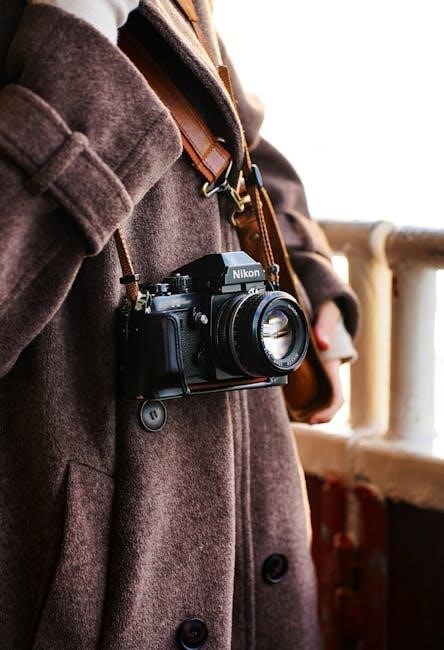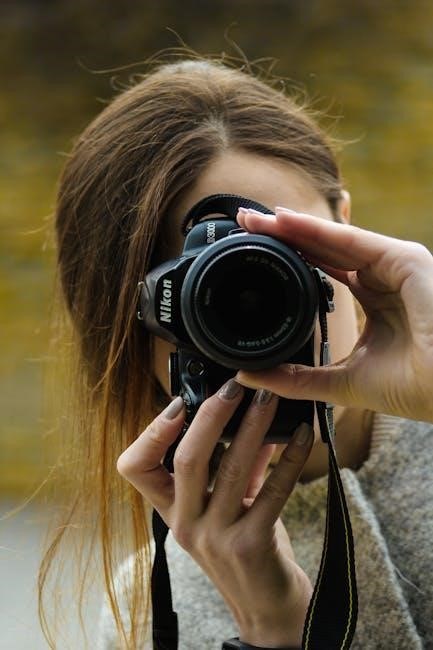Welcome to the Nikon P1000 manual, your comprehensive guide to mastering this powerful camera. Designed for wildlife, sports, and astrophotography, the P1000 offers a 125x optical zoom and 4K video capabilities.
Reading this manual is essential to unlock the camera’s full potential, understand its features, and troubleshoot common issues. It provides detailed instructions for optimal performance and creative control.
The manual is available for download from Nikon’s official website in PDF format. Additionally, the Nikon Manual Viewer 2 app allows easy access to the guide on mobile devices.
1.1 Key Features of the Nikon P1000
The Nikon P1000 boasts an impressive 125x optical zoom (24-3000mm equivalent), making it ideal for wildlife and astrophotography. It supports 4K video recording, manual exposure control, and RAW image capture; The camera features a built-in 2.3-million dot OLED electronic viewfinder, Wi-Fi, and Bluetooth connectivity. Its 16-megapixel sensor and Vibration Reduction technology ensure sharp images. The P1000 also offers a flash hot-shoe and compatibility with Nikon accessories, enhancing its versatility for professional and amateur photographers alike.
1.2 Importance of Reading the Manual
Reading the Nikon P1000 manual is essential to fully understand its features and optimize performance. It provides detailed guidance on using the 125x zoom, 4K video, and RAW capture. The manual helps troubleshoot common issues and explains advanced settings like manual focus and exposure control. Available in PDF and via the Nikon Manual Viewer 2 app, it ensures you master the camera’s capabilities for professional-quality results, whether you’re a novice or an experienced photographer.
1.3 How to Download the Nikon P1000 Manual
To download the Nikon P1000 manual, visit Nikon’s official website and navigate to the support section. Select the P1000 model and choose the reference manual or quick start guide. Both are available in PDF format. Additionally, the Nikon Manual Viewer 2 app allows easy access to the manual on iOS and Android devices. Ensure you download the correct version for your language to make the most of your camera’s features.

Camera Controls and Layout
The Nikon P1000 features an intuitive control layout with ergonomic design, making it easy to navigate. The camera’s controls are strategically placed for quick access to settings and functions.
2.1 Top Controls: Mode Dial, Shutter Button, and Zoom Lever
The Nikon P1000’s top controls include a mode dial for selecting shooting modes, a shutter button for capturing images, and a zoom lever for adjusting focal length. The mode dial allows quick access to settings like manual mode, while the shutter button features a smooth, responsive design. The zoom lever enables precise control over the camera’s 125x optical zoom, making it ideal for capturing distant subjects with ease and accuracy.
2.2 Rear Controls: LCD Screen, Viewfinder, and Navigation Buttons
The rear of the Nikon P1000 features a 3.2-inch vari-angle LCD screen for framing shots and reviewing images. The electronic viewfinder provides a clear, 2.3-million dot OLED display for precise composition. Navigation buttons and a multi-selector enable intuitive menu browsing and settings adjustment, while the LCD screen supports touch functionality for added convenience and quick focusing during shooting sessions.
2.3 Lens Controls: Focus Ring and Vibration Reduction Switch
The Nikon P1000 features a focus ring for precise manual focusing, allowing you to fine-tune your shots with ease. The Vibration Reduction (VR) switch enables optical image stabilization, minimizing camera shake and blur, especially at high zoom levels. These controls enhance sharpness and stability, ensuring clearer images even in challenging conditions like handheld shooting or wildlife photography.

Setting Up the Camera for the First Time
Start by charging the battery and inserting the memory card. Follow the on-screen prompts to set your language, date, and time. The quick start guide helps you begin shooting and reviewing images effortlessly.
3.1 Charging the Battery and Inserting the Memory Card
Charge the battery using the supplied MH-67P charger. Insert a compatible SD, SDHC, or SDXC memory card into the slot. Connect the charger to a USB port. Avoid using non-Nikon accessories to prevent damage and warranty issues. Ensure the camera is turned off before inserting the card. This step ensures your camera is ready for initial setup and use, with proper power and storage solutions.
3.2 Initial Setup: Language, Date, and Time
After turning on the camera, navigate to the menu to select your preferred language. Use the navigation buttons to scroll through options and confirm with the OK button; Next, set the date and time, ensuring accuracy for proper photo timestamping. Refer to the manual for detailed steps on configuring these settings correctly. Proper initialization ensures your camera is ready for use and maintains accurate records of your photos.
3.3 Quick Start Guide: Basic Shooting and Playback
Start by turning on the camera and ensuring the lens cap is removed. Use the mode dial to select Auto mode for point-and-shoot simplicity. Frame your subject using the LCD screen or electronic viewfinder, then press the shutter button halfway to focus and fully to capture the image. For playback, press the playback button to review your photos, use the zoom lever to enlarge details, and delete unwanted images using the delete button. The menu button provides access to additional settings for customization.
Use the navigation buttons to scroll through images and adjust settings quickly. This guide helps you begin shooting and reviewing photos efficiently, ensuring a smooth start with your Nikon P1000.
Shooting Modes
The Nikon P1000 offers versatile shooting modes, including Automatic, Scene, and Manual, catering to photographers of all skill levels. These modes simplify or enhance creative control, ensuring optimal results in various conditions, from point-and-shoot simplicity to advanced customization, helping you capture your best shots effortlessly.
4.1 Automatic Mode: Point-and-Shoot Simplified
Automatic Mode simplifies photography, making it ideal for beginners or quick shots. The camera automatically adjusts exposure, focus, and settings, ensuring great results with minimal effort. Perfect for capturing spontaneous moments, this mode optimizes the camera for various lighting conditions and subjects, allowing you to focus solely on composition and creativity. It’s a hassle-free option for achieving professional-quality images without manual adjustments, making it perfect for point-and-shoot photography.
4.2 Scene Modes: Optimizing for Specific Conditions
Scene Modes on the Nikon P1000 optimize camera settings for specific scenarios, such as portraits, landscapes, and sports. Each mode adjusts exposure, ISO, and white balance to capture the best results. Whether shooting close-ups or dynamic action, these modes ensure vibrant colors and sharp focus. They simplify photography by automatically adapting to the scene, allowing users to achieve professional-quality images effortlessly.
4.3 Manual Mode: Taking Full Creative Control
Manual Mode on the Nikon P1000 empowers photographers to take full creative control. Adjust aperture, shutter speed, and ISO sensitivity to achieve precise results. This mode is ideal for advanced users who want to experiment with lighting, depth of field, and motion effects. With manual focus and exposure compensation, users can fine-tune every detail. It’s perfect for capturing unique perspectives and unlocking the camera’s full artistic potential.
Image Quality and Settings
Master image quality by adjusting resolution, compression, and ISO sensitivity. Fine-tune white balance for accurate colors and explore RAW capture for preserving detailed image data.
5.1 Understanding Image Resolution and Compression
The Nikon P1000 allows you to capture images in various resolutions, ensuring detailed photos. Compression settings like Fine, Normal, and Basic optimize file size without sacrificing quality. Higher resolutions retain more detail, ideal for enlargements, while lower settings reduce storage needs. Properly balancing resolution and compression ensures your photos are crisp and efficiently stored, enhancing your overall photography experience with the P1000.
5.2 Adjusting ISO Sensitivity for Optimal Results
ISO sensitivity on the Nikon P1000 controls light capture, with lower settings (ISO 100-400) ideal for bright conditions to minimize noise. Higher ISOs (up to 6400) are best for low-light situations but may introduce grain. Adjusting ISO balances image brightness and noise, ensuring sharp, clear photos. Experiment with settings to find the perfect balance for your shooting environment and achieve professional-quality results effortlessly.
5.3 White Balance: Capturing Accurate Colors
White balance ensures accurate color representation in various lighting conditions. Use presets like Auto, Daylight, Cloudy, or Incandescent for quick adjustments. For precise control, manually adjust the color temperature in the menu settings. The live preview allows you to evaluate changes before capturing the image. This feature is essential for achieving natural-looking photos and preserving the true colors of your subject, making it a valuable tool for enhancing your photography skills and creativity.
5.4 RAW Image Capture and Its Benefits
RAW image capture preserves all data from the camera sensor, offering greater flexibility in post-processing. It retains more detail, allowing adjustments to exposure, contrast, and color without degrading image quality. For professional photographers, RAW files provide creative control and higher quality output. The Nikon P1000 supports RAW shooting, enabling you to capture images with maximum detail and versatility for advanced editing and professional results.

Video Recording
The Nikon P1000 captures stunning 4K UHD videos at 30p and 1080p at 60p, with manual exposure control for precise adjustments and clean HDMI output for monitoring.
6.1 4K Video Capabilities and Settings
The Nikon P1000 supports 4K UHD video recording at 30p and 1080p at 60p, offering sharp and detailed footage. Manual exposure control allows for precise adjustments, while clean HDMI output enables external monitoring. The camera also features high-speed video modes for creative effects and built-in stereo microphones for enhanced audio quality, making it versatile for various video recording needs.
6.2 Frame Rates and Video Quality Options
The Nikon P1000 offers versatile frame rates, including 4K UHD at 30p and Full HD at 60p, ensuring smooth and detailed video capture. High-speed video modes are available for creative slow-motion effects. Video quality can be adjusted to prioritize file size or image detail, and manual exposure control allows for precise adjustments during recording. These options make the P1000 suitable for various video recording needs, from casual to professional use.
6.3 Manual Exposure Control in Video Mode
The Nikon P1000 allows full manual exposure control during video recording, enabling precise adjustments to aperture, shutter speed, and ISO sensitivity. This feature provides flexibility for professional-grade video production. Exposure compensation and white balance settings can also be fine-tuned for optimal results. Additionally, the camera supports clean HDMI output, allowing for high-quality external recording without overlays, making it ideal for advanced videography and cinematic applications.
Advanced Features
The Nikon P1000 offers advanced features like manual focus for precise control, RAW image capture for detailed post-processing, and an electronic viewfinder for enhanced shooting experiences.
7.1 Manual Focus: Precision in Your Shots
Manual focus on the Nikon P1000 allows for precise control, enabling photographers to capture sharp images. The focus ring provides smooth adjustment, perfect for macro, portraits, and low-light photography. This feature ensures enhanced accuracy, giving you full creative control over your shots. Mastering manual focus elevates your photography, making it an essential skill for any photographer seeking professional results.
7.2 RAW Shooting: Preserving Image Data
Shooting in RAW format with the Nikon P1000 preserves maximum image data, offering greater flexibility in post-processing. Unlike JPEG, RAW files retain more detail, allowing for superior editing of exposure, color, and noise reduction. This feature is ideal for professional photographers who require high-quality images and precise control over their final output. Capturing in RAW ensures that your photos remain untouched by in-camera processing, maintaining their original integrity.
7.3 Electronic Viewfinder: Enhancing Your Shooting Experience
The Nikon P1000 features a high-resolution 2.3-million dot OLED electronic viewfinder, providing a clear and detailed preview of your shots. This advanced viewfinder enhances visibility, especially in bright lighting conditions, and allows for precise composition and focus control. It supports manual focus adjustments and exposure compensation, ensuring a more immersive and professional shooting experience. The viewfinder is a valuable tool for capturing sharp, well-framed images with ease and precision.

Customizing Your Camera
The Nikon P1000 allows extensive customization to suit your preferences. Adjust settings, assign functions to buttons, and create a personalized My Menu for quick access to frequently used features.
8.1 Custom Settings: Tailoring the Camera to Your Needs
The Nikon P1000 offers customizable settings to align with your photography style. Adjust ISO sensitivity, white balance, and exposure compensation to capture images precisely as you envision them. These settings enable personalized control, ensuring optimal results in various lighting conditions and creative scenarios. By tailoring the camera to your preferences, you can enhance image quality and streamline your workflow for a more intuitive shooting experience.
8.2 Button Customization: Assigning Functions
The Nikon P1000 allows you to customize button functions, optimizing your workflow. Assign frequently used settings like ISO, AF, or white balance to specific buttons. This feature enhances efficiency and personalizes your shooting experience, ensuring quick access to essential controls. Customize buttons to suit your preferences for a more intuitive and streamlined photography process.
8.3 My Menu: Creating a Personalized Menu
The Nikon P1000’s My Menu feature allows you to create a personalized menu with your most frequently used settings. Add, organize, and access custom options like ISO, AF modes, or white balance. This feature streamlines your workflow, providing quick access to essential functions. By tailoring My Menu to your preferences, you can enhance efficiency and enjoy a more intuitive shooting experience.

Connectivity and Sharing
The Nikon P1000 offers seamless connectivity through Wi-Fi and Bluetooth, enabling easy image transfers to smartphones or computers. The camera also supports HDMI output for external displays.
These features allow photographers to share their work instantly and view high-quality images on larger screens, enhancing both productivity and creativity.
9.1 Wi-Fi and Bluetooth Connectivity
The Nikon P1000 features built-in Wi-Fi and Bluetooth, enabling quick and easy connection to smartphones and tablets. Using these wireless technologies, users can transfer images and videos directly to their devices. The SnapBridge app allows for seamless sharing and remote camera control. This connectivity enhances workflow efficiency and ensures photographers can share their work instantly. Additionally, Bluetooth maintains a constant low-energy connection for convenient pairing.
9.2 Transferring Images to Smartphones or Computers
Transferring images from the Nikon P1000 to smartphones or computers is straightforward using Wi-Fi and Bluetooth connectivity. The SnapBridge app enables automatic image transfer and remote camera control. Users can select specific images or transfer entire albums wirelessly. Additionally, images can be transferred via USB cable or memory card readers for faster backups. This ensures seamless sharing and storage of your captured moments.
9.3 HDMI Output for External Displays
The Nikon P1000 features an HDMI output, enabling connection to external displays for real-time video preview or playback. This is ideal for professional monitoring and recording setups. The clean HDMI output ensures high-quality video without camera info overlays, allowing for precise framing and focus checks. This feature enhances workflow efficiency for photographers and videographers aiming for professional-grade results.
Maintenance and Troubleshooting
Regularly clean the lens and camera body to prevent damage. Update firmware for optimal performance. Troubleshoot common issues like connectivity problems or error messages promptly.
10.1 Cleaning the Camera and Lens
Use a soft, dry cloth to wipe the camera body and lens. For stubborn smudges, dampen a microfiber cloth with distilled water. Avoid harsh chemicals or abrasive materials. Clean the lens in a circular motion, starting from the center. Never touch the lens surface with bare hands. Regular cleaning prevents scratches and ensures optimal image quality. Store the camera in a protective case to minimize dust exposure. Always clean in a cool, dry environment to avoid moisture damage.
10.2 Updating Firmware: Keeping Your Camera Current
Regularly update your Nikon P1000’s firmware to ensure optimal performance and access new features. Visit Nikon’s official website, download the latest firmware, and follow the instructions provided. Use a fully charged battery and a formatted memory card for the update. Avoid turning off the camera during the process. Updating firmware enhances functionality, fixes issues, and maintains compatibility with accessories. Always use Nikon-approved devices to prevent damage and warranty voidance.
10.3 Common Issues and Solutions
Common issues with the Nikon P1000 include camera damage from third-party accessories, which can void the warranty. If the camera or charger is damaged after an accident, contact a Nikon-authorized service representative. For lens errors or memory card issues, turn off the camera, wait, and restart. Format memory cards regularly to prevent data corruption. Always use Nikon-approved accessories to ensure compatibility and maintain warranty coverage.

Resources and Support
Visit Nikon’s official website for manuals, firmware, and customer support. Use the Nikon Manual Viewer 2 app for easy access to guides on your mobile device. Contact Nikon support for assistance or join online communities for troubleshooting and tips from experienced users.
11.1 Downloading the Nikon P1000 Reference Manual
To download the Nikon P1000 Reference Manual, visit Nikon’s official website. Navigate to the “Manuals” section, select your camera model, and choose the reference manual in PDF format. The manual provides detailed instructions for camera settings, features, and troubleshooting. Additionally, the Nikon Manual Viewer 2 app allows you to download and view the manual on your smartphone or tablet for convenient access.
11.2 Nikon Official Support and Customer Service
For assistance with your Nikon P1000, visit Nikon’s official website to access support resources. Explore FAQs, troubleshooting guides, and repair services. Contact Nikon’s customer service directly for personalized help. Authorized service centers are available for camera maintenance and repairs, ensuring your P1000 operates at its best.
11;3 Online Communities and Forums
Engage with online communities and forums dedicated to Nikon enthusiasts. These platforms offer valuable insights, troubleshooting tips, and shared experiences from P1000 users. Participate in discussions to enhance your photography skills and resolve technical queries. Popular forums include Nikon’s official community, Reddit, and specialized photography groups. Connecting with fellow photographers fosters learning and creativity, helping you maximize your P1000’s capabilities.
